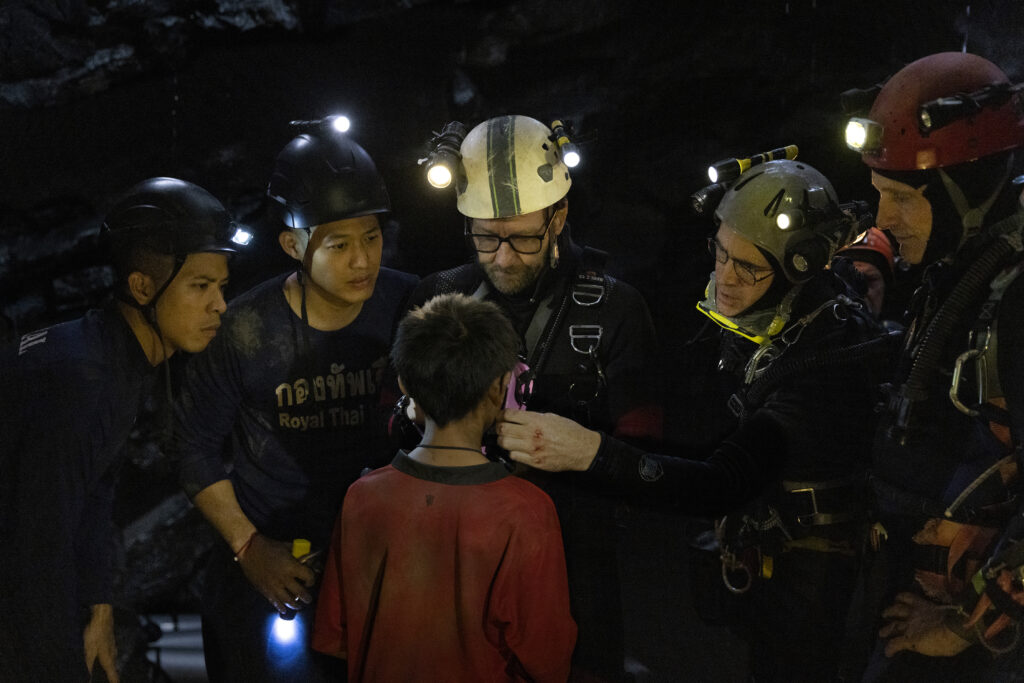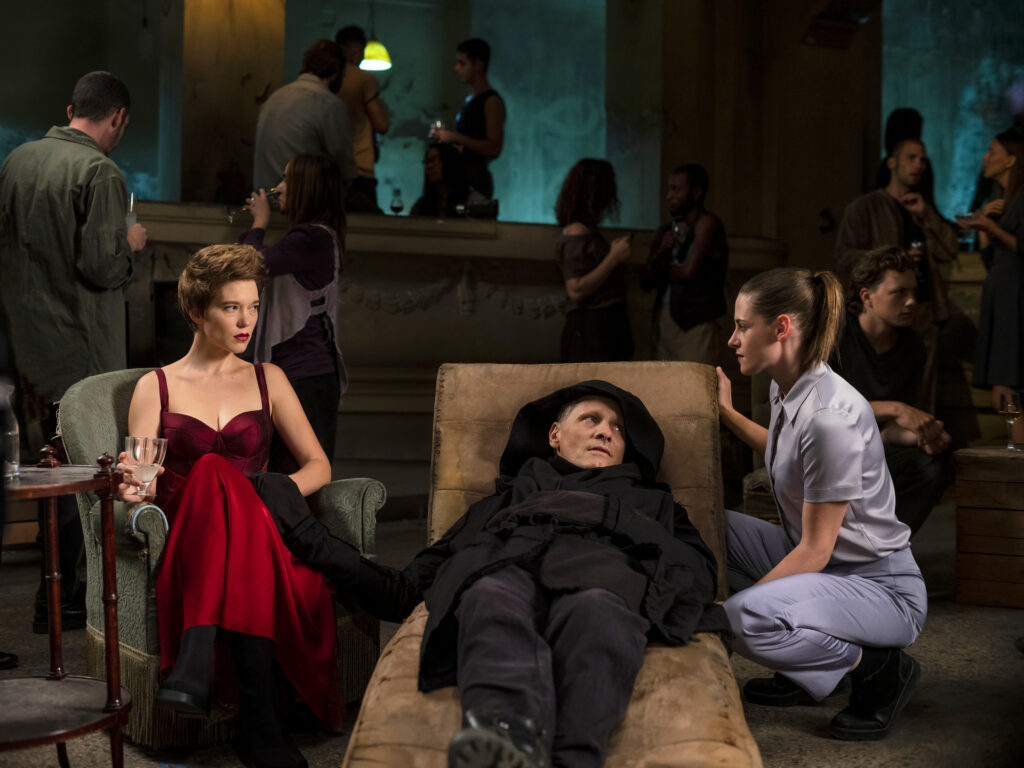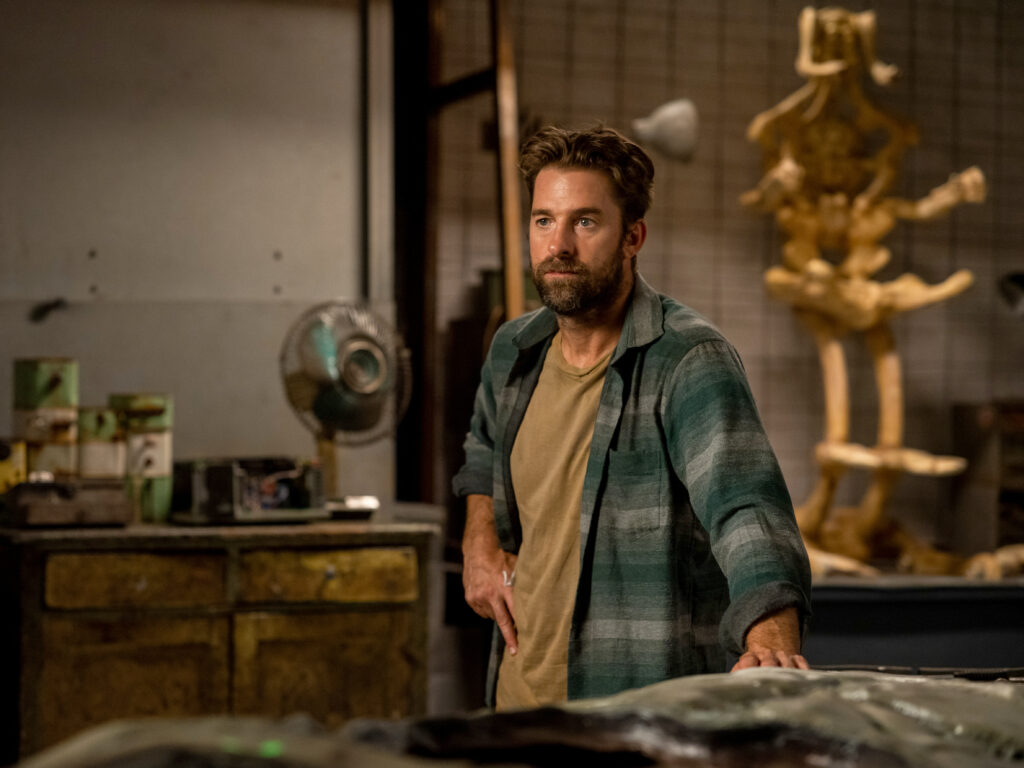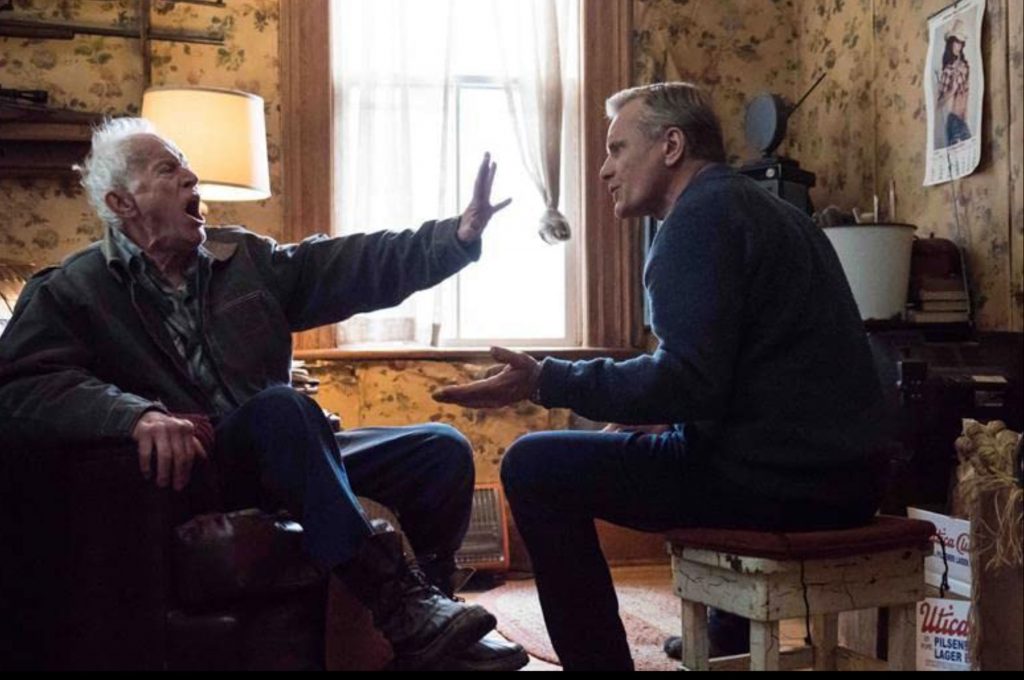July 25, 2022
by Carla Hay

Directed by Ron Howard
Some language in Thai with subtitles
Culture Representation: The dramatic film “Thirteen Lives” features a cast of white and Asian characters depicting working-class and middle-class people involved in the real-life mission to rescue 12 boys and their soccer coach, who were trapped in Tham Luang Nang Non cave in Thailand, from June 23 to July 10, 2018.
Culture Clash: The rescuers had to overcome language barriers, cultural differences and conflicts over the best rescue methods in order to complete the mission.
Culture Audience: “Thirteen Lives” will appeal primarily to people interested in watching a very Hollywood and formulaic rescue mission story that sidelines or erases many of the perspectives of the real-life Asian people involved.

“Thirteen Lives” is a bland, scripted counterpart to the superior documentary “The Rescue,” presented mainly from the perspectives of the rescuers who saved 13 people trapped in Tham Luang Nang Non cave in Thailand in 2018. This bloated drama fails to properly acknowledge the 13 Thai survivors who were trapped in the cave, in an ordeal that lasted 18 days. This misleadingly titled movie called “Thirteen Lives” isn’t about those 13 lives. It’s mostly about the lives of the two British men who are touted as the movie’s biggest heroes, with a third man from Australia as a pivotal hero sidekick.
The award-winning 2021 documentary “The Rescue” couldn’t have the perspectives of the trapped people (in 2018, they were 12 boys ranging in ages from 11 to 16 and their 25-year-old soccer coach) because Netflix bought the exclusive rights to their stories. However, as a dramatic and scripted film, “Thirteen Lives” (directed by Ron Howard and written by William Nicholson) had the freedom to at least give viewers a sense of what it must have been like for the 13 survivors to go through this ordeal, based on news reports and what the survivors and their families told the media. As it stands, “Thirteen Lives” gives the bare minimum of screen time to the Thai people who suffered the most during this crisis.
Instead, the movie is all about giving the most screen time and praise to the British and Australian cave divers who volunteered their services, with Thai cave divers and Thai officials treated as supporting characters. Two middle-aged Brits in particular are spotlighted as the chief heroes: Rick Stanton (played by Viggo Mortensen) and John Volanthen (played by Colin Farrell), two cave-diving friends who volunteered their services and sometimes have to battle against stubborn Thai officials who are skeptical of Rick’s and John’s ideas. “Thirteen Lives” shows more information about John’s family than any of the families of the trapped victims combined.
The crisis began on June 23, 2018, when the boys (who were all on the same soccer team) and the team’s assistant coach decided to spend some time exploring the cave in the afternoon. Located in northern Thailand’s Chiang Rai Province, the cave stretches for 10,000 meters or 6.2 miles. Monsoon rain storms that were expected later that summer arrived earlier than expected and flooded the cave, thereby trapping the boys and their coach. “Thirteen Lives” gives only one child in the group anything resembling acknowledgement that he is an individual human being. His name in the movie is Chai (played by Pasakorn Hoyhon), but there is very little revealed about him or his personality.
Chai’s mother Buahom (played by Pattrakorn Tungsupakul) is the only parent of the 12 boys who has screen time that shows something that looks like individuality. She’s the only parent in “Thirteen Lives” who’s given specific scenes where she’s shown talking to rescue officials (often in angry frustration) to get the latest information on the search and rescue efforts. Before she finds out that Chai is trapped in a cave, Buahom mentions early on in the movie that she wishes that she could go to more of his soccer games, but she can’t because she has to work. That’s all the information that viewers will get about her.
“Thirteen Lives” makes Bauahom such a marginal role, viewers will have a hard time remembering if her first name was even said in the movie. It’s almost offensive how “Thirteen Lives” makes Bauahom the “token family member” and brushes aside all the other survivors’ family members who were in agony too. Any other family members shown in the movie are essentially background characters, with few of them having any lines of dialogue.
Meanwhile, “Thirteen Lives” gives plenty of time for viewers to get to know John (an information technology consultant) and Rick (a retired firefighter), both natives of England who share a passion for cave diving in their spare time. John is a happily married father who is shown at home with his family before and after he goes to Thailand for this rescue mission. Rick’s personal life is not shown, but he mentions at one point that he doesn’t like kids very much.
John tends to be optimistic. Rick tends to be pessimistic. The movie shows that it was John’s idea to contact Rick to be a part of this rescue mission after it made international news. The two men, who have been on-again/off-again close friends in their social circle of cave diving fanatics, consider themselves to be experts with years of experience diving in the types of caves where most people would not dare to go.
John’s and Rick’s names end up on a list of potential rescuers given to the Thai government when the Thai Navy SEALs find out almost all of the Thai Navy SEALs don’t have the training to dive in the type of cave where the boys and their coach are trapped. Thai officials and rescuers are put in the story as either helpful or not-very-helpful to what John and Rick want to do. Expect to see trite and predictable scenes of language barriers and egos having an effect on any tension-filled communication between the non-Thai people and the Thai people.
Vern Unsworth (played by Lewis Fitz-Gerald) is another Brit cave diver who’s on the scene because he’s very familiar with the cave. He’s in his 60s and is more experienced than John and Rick when it comes to knowing about Thai government politics. He tells his fellow Brits that Governor Narongsak (played by Sahajak Boonthanakit) is on his way out of office, but the governor was asked to stay on the job during this cave crisis, “in case they need a fall guy” if anyone dies.
Other rescue cave divers who make appearances include Thai Navy SEALs named Commander Kiet (played by Thira Chutikul), Suman (played Sukollawat Kanarot) and Pichai (played by Bernard Sam), who are all written as very generic characters. If you know what happened in real life, then you know that one of these Thai Navy SEALs heroically died during this rescue. (His death and funeral are depicted in “Thirteen Lives.”) One of the rescue cave divers is a Thai medical professional named Dr. Karn (played by Popetorn Soonthornyanakij), who can speak Thai and English.
Other military officials depicted in “Thirteen Lives” include Thailand’s minister of interior General Anupong (played by Vithaya Pansringarm) and the U.S. Air Force’s Major Hodges (played by Josh Helman) and Captain Olivia Taft (played by Zahra Newman), who is the token female military character to have a speaking role in the movie. All of these supporting roles are written as ultimately following what John and Rick want to do. Because most people watching this movie already know the real-life outcome of this rescue mission, there’s no real suspense in any of these decision-making conflicts.
There are two other Westerners who end up featuring prominently in “Thirteen Lives” as rescuers: British Cave Rescue Council member Chris Jewell (played by Tom Bateman) has the role of the strapping young cave diver who is supposed to be less experienced than John and Rick. And then there’s anesthesiologist Dr. Richard “Harry” Harris (played by Joel Edgerton), an Australian who’s called on by Rick and John later in the movie to implement a radical and risky idea.
While all this political maneuvering and ego posturing is going on outside the cave, “Thirteen Lives” viewers get only the briefest of glimpses on what the trapped victims were experiencing inside the cave. There’s so much about their survival that was in the news in real life that was left out of “Thirteen Lives,” because apparently the filmmakers thought it was more important to have scenes of Rick and John moping around when they were both temporarily barred from being part of the search and rescue.
When Rick is part of the team that finds the boys and the coach, he has this to say in a private conversation with John: “I knew we’d find them. I didn’t expect to find them alive.” The movie is filled with maudlin dialogue. John and Rick show very little interest in knowing who the boys and the coach are, perhaps as a way not to get too personally involved with people who might die in the cave. In the movie, John and Rick are depicted as more concerned about their own reputations as cave divers and rescuers.
“Thirteen Lives” gives viewers only superficial snippets of what it took for these boys and their coach to survive under these extremely traumatic conditions. In one scene, the boys tell their rescuers that Coach Ek (played by Teeradon Supapunpinyo) instructed them to meditate and not let fear overtake them. The boys are depicted as stoic, with almost no filmmaker effort to put names to faces, except for Chai, who still has a non-descript personality.
Getting the trapped people out of the cave was complicated by the tricky and dangerous route to get to their location in the cave. Numerous people inside and outside the cave also had to keep diverting rain water to prevent more flooding. Therefore, it took several days after the survivors were found until they could be removed from the cave. All of this is depicted in “Thirteen Lives” in a very perfunctory, “by the numbers” manner, with little regard to what the people trapped inside the cave must have been feeling.
The stops and starts of this rescue also drag down “Thirteen Lives,” to the point where even the rescuers look bored at times. No one does a terrible acting performance in the movie, but “Thirteen Lives” is by no means going to win any major awards for its acting performances. And at an overly long total run time of nearly two-and-half-hours, “Thirteen Lives” would have greatly benefited from better editing. There are only so many times when viewers need to see clinical-looking timelines focusing on scowling Rick and worried John before it gets tedious very quickly.
While these two rescuers are brooding in their hotel or at the rescue camp, there’s a more urgent and compelling story inside the cave that’s shut out of this movie. If people expect “Thirteen Lives” to give fascinating or informative insight into what it’s like to survive while trapped in a flooded cave for 18 days with very little food and fresh water, then there will be viewer disappointment, because “Thirteen Lives” is not that movie. There’s a lot of information in the public domain about this survival story that the “Thirteen Lives” filmmakers chose not to put in the movie. The messages that the trapped people sent to their loved ones get barely one or two minutes of screen time in “Thirteen Lives.”
Toward the end of the movie, there’s a brief flash of a message board displaying the photos of the 13 trapped victims, but no one ever says all of their individual names out loud in “Thirteen Lives,” even though these survivors are the movie’s namesakes. Only a few of their names are mentioned, but the movie gives no depictions of their individual personalities. Even if the “Thirteen Lives” filmmakers couldn’t use the real-life names, they could have given viewers an empathetic sense of who these survivors are as people, but the “Thirteen Lives” filmmakers chose not to do that. This omission is a travesty and a major failing of “Thirteen Lives.”
The survivors’ family members are sidelined for most of the movie as mostly nameless, weeping and praying people whose anguish is given the Hollywood treatment. Their traumatic experiences are treated as a lot less important than pushing the narrative that the Thai people were ineffective in this crisis until non-Thai people came to the rescue with the best ideas and the best skill sets. Any teamwork shown in the movie is with a tone that the Westerners/non-Thai people are the superior ones on the team.
This real-life cave rescue has been the basis of several on-screen retellings of the story. In addition to “Thirteen Lives” and “The Rescue,” there’s the dramatic movie “The Cave,” which was originally released in Thailand in 2019, and is set for a theatrical and home video release in the U.S. (under the title “Cave Rescue”) via Lionsgate on August 5, 2022—the same date that “Thirteen Lives” premieres on Prime Video. Written and directed by Tom Waller, “The Cave”/”Cave Rescue” (which got mostly negative reviews) features a cast of little-known actors and some of the real-live cave divers portraying themselves. In addition, Netflix’s limited drama series “Thai Cave Rescue” is set to premiere on September 22, 2022.
While all these film and TV people are trying to cash in on this story, here are the names of the survivors of this crisis: Mongkhon “Mark” Bunpiam, Somphong “Pong” Chaiwong, Ekkaphon “Eak” Kanthawong (the coach), Phonchai “Tee” Khamluang, Duangphet “Dom” Phromthep, Phiphat “Nick” Phothi, Phanumat “Mig” Saengdi, Adun “Dul” Sam-on, Phiraphat “Night” Somphiangchai, Prachak “Note” Sutham, Natthawut “Tern” Thakhamsong, Chanin “Titan” Wibunrungrueang and Ekkarat “Bew” Wongsukchan.
“Thirteen Lives” might not want viewers to know their individual names, but anyone who really cares about this true story should at least acknowledge that these survivors are people with their own individual lives, hopes and dreams. Their survival story is inspirational, but “Thirteen Lives” uses it as a cynical plot device. These survivors shouldn’t be mostly nameless and generic background characters to put in a Hollywood movie, in order to make other people look more important.
United Artists Releasing/Metro Goldwyn Mayer Pictures will release “Thirteen Lives” in select U.S. cinemas on July 29, 2022. Prime Video will premiere the movie on August 5, 2022.




